 In recent years, many studies have reported on demographic differences in tobacco use and tobacco-related health issues among American adults. Other research has revealed tobacco advertisements are more likely to appear in historically ethnic neighborhoods compared to White neighborhoods.
In recent years, many studies have reported on demographic differences in tobacco use and tobacco-related health issues among American adults. Other research has revealed tobacco advertisements are more likely to appear in historically ethnic neighborhoods compared to White neighborhoods.
A new study published in JAMA Network Open has revealed a similar racial disparity among tobacco advertisements on TV and streaming platforms. Compared to other racial groups, African Americans are significantly more likely to encounter tobacco marketing when watching traditional TV or using streaming platforms.
The study authors examined a sample of 5,775 American adults who participated in the National Cancer Institute’s 2022 Health Information National Trends Survey. The survey asked participants to recall how often they noticed tobacco products being advertised, marketing, or promoted over the past three months in several different mediums, including TV and streaming platforms.
The authors found roughly 12.4 percent of all participants reported exposure to tobacco-related advertisements when watching TV traditionally or via streaming platforms. However, exposure among Black Americans was 19.4 percent – the highest rate of exposure among all racial groups analyzed. High rates of exposure were also found among Americans aged 35-49 (13.4 percent), those with a high school education or less (16.4 percent), those with a household annual income less than $20,000 (17.6 percent), and among those who currently smoke (17.0 percent).
“As these platforms continue to dominate the entertainment landscape, it becomes increasingly important to regulate content that may contribute to detrimental health outcomes associated with smoking,” the authors write. They suggest public health policymakers leverage their findings when developing interventions to mitigate the impact of tobacco marketing, particularly among vulnerable populations.
The authors include scholars from Harvard Medical School, the University of Washington, Baylor College of Medicine, Texas A&M University, the University of Texas, and several hospitals across the country.











